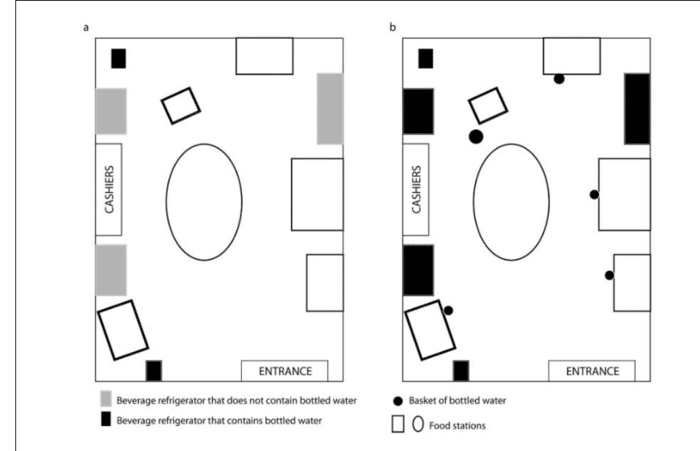
In December 2009, Dr Anne Thornpike and her team of colleagues had an idea to help improve the healthy eating habits of employees of Massachusetts General Hospital in Boston. She believed she could improve the eating and drinking habits of thousands of the hospital staff without telling them…
So what did they do? They re-designed their environment.
“Design beats willpower” – B. J. Fogg
You see what most people don’t realise is that most eating and drinking decisions are done mindlessly – meaning we consume most of our food and drink not because of what it is but because of where it is.
Taking this into account, Thornpike and her team started rearranging the cafeteria environment making the following changes to start:
- First, they started by changing how drinks were positioned, Originally, the refrigerators located next to the cash tills in the cafeteria and were filled with only fizzy drinks.
- Secondly, the designers added water as an option in each row.
- Lastly, baskets of bottled water were placed next to the food stations throughout the room. Soda was still in the primary refrigerators, but water was now available at all drink locations.
Image A below shows what the room looked like before the environment was redesigned, while B shows the room after the changes. The black boxes indicate areas where bottled water was positioned.

What happened?
After three months, the number of fizzy drinks dropped at the hospital by 11.4%. Meanwhile, sales of bottled water increased by 25.8%.
Remember, nobody said a word about what was going on, people just followed on mindlessly making improved decisions for their health. Their environment was simply shaping the path.
Similar results were seen with a simple traffic system on food in the same hospital years later from 2016 – 2018, 602 Massachusetts Hospital employees who regularly used the hospital’s cafeterias took part in the hospital’s “Choose Well, Eat Well” program.
Foods and drinks in the hospital canteen were given “traffic light” labels to indicate their nutrition value: green is healthy, yellow was less healthy, and red was unhealthy.
Just like the water design study above, food items were also rearranged to put healthier choices in the direct line of sight, while unhealthy foods were made less visible to reduce impulse purchases, (out of sight out of mind).
The results showed that employees with the lowest HPS (least healthy purchases) had the lowest overall dietary quality and the highest risk for obesity, diabetes, and high blood pressure. Healthier purchases were associated with higher dietary quality and lower prevalence of obesity, hypertension, and prediabetes/diabetes.
What does all this tell us?
You can design a better environment for your employees by strategically making healthier options more visual in the workplace as well as gently reminding them of what those healthier choices are.
Here are a few ways you can redesign the workplace environment to support your employee’s health.
- If you want to help your employees eat better, make healthier foods the default option and unhealthy ones less accessible
- If you want them to drink more water, put more water stations in their path or leave water bottles on the desks each morning
- If you want to remind them what healthy food is, put a traffic light system in place at the point of purchase.
- If you want them to move more, make walking meetings “a thing”, have a standing desk station or create a travel plan unique to your location
Bottom line:
Workplace environmental design is a powerful tool that is underutilized in most workplaces. We live in a world where we can easily be roped into unhealthy behaviours because of the environmental design. Be your own architect and build a better one for you as an employer and your employees.
If you want to find out more about how you can support your employees’ wellbeing, take a look at Health@Work’s wellbeing courses.
